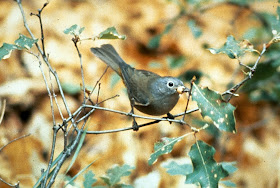 |
| Photo courtesy, David Elkowitz, Big Bend National Park, National Park Service |
"The path to see the Colima Warbler is not an easy one. You must hike or ride a horse nine miles--but every single inch is well worth it! Starting early in the morning from the Basin trailhead, the air is cool and fragrant. After a rain or heavy dew, damianita purfumes the mountain air like creosote pervades the desert air. Dewdrops glisten on spider webs as you hike upward. Juniper, oak, and pinyon pine line the Pinnacles Trail, which provides breathtaking views of the Basin and the enchanting distant desert."
Later--
"In no time at all you reach the top - Piannacles Pass. The 1600 foot gain was quite painless with so much to see and investigate. while snacking and enjoying the spectacular view from the pass, you watch aerobatic Mexican jays, also known as gray-breasted jays, dip dive and scold. Walking toward Boot Canyon, the upside-down boot comes into view. As you hike on, the shape becomes even more apparent. All of a sudden, the sound you have been straining to hear echoes through the canyon: a high trill endind ing one or two lower notes. while standing still and not daring even to breathe, you see a small active bird fly across your path and perch in an oak. A quick glimpse through your binoculars reveals a five-ince long, grayish-backed, pale-breasted bird with a bright yellow-orange rump and undertail coverts and a white eye-ring. A really good look in excellent light may reveal a rusty cap. You have had less than a minute to look. Now it is gone, leaving only the pounding of your heart and a smile on your face. You are one of the lucky few to see a Colima warbler.
The first Colima was discovered nesting in teh Chisos Mountains over 55 years ago. Since then, thousands of people have come thousands of miles just to see this rare warbler. Big Bend National Park is the only place in the United States where the Colima can be seen. Colimas return each April to build their ground nests of grass, moss, bark and fur and to lay their four creamy-white speckled and blotched eggs. They stay until September when the call to return to their winter homes in south and central Mexico is too strong to resist."
No comments:
Post a Comment